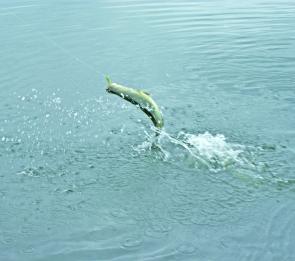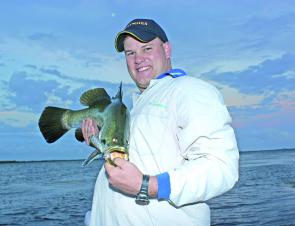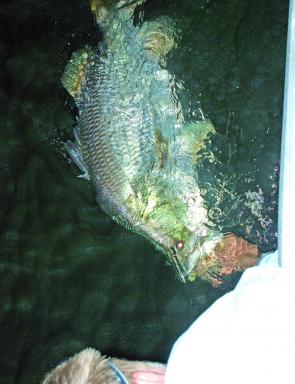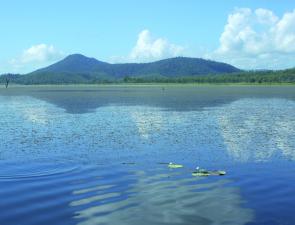Impoundment barra anglers’ intentions seemed to have changed in the last few years with many not trying to fill their freezers or catch the metre-plus barra but rather just enjoy the challenge of capturing these amazing fish.
In the cooler months from May to August, the challenge is greater and the rewards are sweeter so skill and knowledge can work for keen anglers. With vast weed beds and little structure, Kinchant Dam barra often seek warmer waters so this is the perfect place for surface barra fishing.
Kinchant Dam is located 41km west of Mackay and is mainly known within the region as a water skiing dam. It has only been over the past two years that fishing has really taken off in the dam with many local anglers owing their first metre-plus fish to the relatively small confines.
The rock wall at the dam supplies a deep ledge, which is perfect for trolling, and many anglers gather here around the full moon to troll this ledge back and forward until one of the monster barra decides to consume their lure. This is a very successful technique and can result in some good numbers of fish, both large and small, but as the water cools the barra must leave these depth and head to shallower water. This makes them almost inaccessible to trollers.
Although there is more to trolling then just dragging a lure, most anglers these days prefer to cast lures as this takes relatively more skill and provides many more challenges. Predominantly the most visually exciting form of casting is using surface lures, especially in Kinchant Dam and especially in winter.
Kinchant Dam is unique in its size as at full capacity it only holds 62,800mL of water, in comparison to Lake Awonga that holds 777,000mL. It is one of the smaller barra dams in Queensland. This dam is also different in that 40% of the shoreline is a man-made dam wall, which is perfect for trollers. Long straight runs allow for great depth control and targeting.
As the dam has no distinctive structures, besides weed beds, the area in the warmer months has become a great spot for fishing with surface lures at night when the barra move from the deeper area into the surface layers of the water to feed. This type of surface fishing can be quite scary as there is no warning or indicator of when a fish can hit your lure. And more often then not it is right at your feet, and in the darkness of night this will definitely get the heart rate and adrenaline pumping.
The other side of the dam tapers out to large flat plains that have developed into huge weed beds that support a lot of wild life, including fish, birds and frogs. The area does not only consist of submerged weed, but also lily pads, which in a dam like Kinchant is not just cover for a fish but a source of warmth. During winter the water temperature in Kinchant can be at lows of around 15̊C to highs of 23̊C, this makes finding the warmer water the most important tool in finding fish. This is when the wind becomes your friend as it pushes the warmer surface water into the submerged weed filled bays.
Submerged weed beds will grow out as long as it can still receive sunlight, and as the dam level rises and falls the weed will grow and die. Weed beds are also very sensitive to temperature and during winter they will grow only slightly on the warmer days but on the colder days will almost lay dormant. This is why many weed bed’s depth and structure will barely change for anywhere up to three months.
There are a few different formats of a weed bed and knowing them and where they are leading up to in winter can help when targeting fish on those freezing winter days. A mature weed bed will grow all the way to the surface, often leaving large drop-offs where the water is too deep for the weed to grow. A growing weed bed can be patchy, scattered or just a shallow flat bed with only 1-2ft of water over the top of it. Both these scenarios give a barra the option to ambush the prey but when it comes to the cooler months the growing weed beds are the better option.
Using surface lures is very productive in these areas as not many other lures can be used without hauling in a large head of lettuce.
As many anglers know, barra don’t actually bite their prey, they inhale it. Barramundi do not have the greatest eyesight so inhaling food and the surrounding water is an effective way of being sure their victim ends up in their stomach. Barra eat anything from small fish, insects, frogs, crustacean and even small barra up to half their own length. Imitating these food sources will bring the most success in surface barra fishing.
In winter, Kinchant barra, both large and small, school up on the weed beds and will spend a majority of the day in this warm water, feeding and resting. This makes them an easy target for surface fishing and the best time is in the twilight hours of the day, as this is when the fish do a majority of their eating. In the cooler months, there will only be a short bite period and anglers must be prepared to fish hard once the fish start to feed.
When these fish are schooled up on the weed beds in winter, they will lie almost in hibernation just soaking up the warm water and sunlight. This means the fish aren’t easily spooked and often a boater will run into the fish causing them to sprint off and run into other fish causing them to spook. The end result is up to ten fish sprint off towards the deeper water, leaving huge boils and bow waves in the water behind them.
Kinchant weed bed barra have been known to travel through the water like torpedoes in an effort to eat your lure. This is a really impressive sight to see and when these fish hit your lure, they leave impressions on the water that can only be described in one word – explosive!
Kinchant weed beds are perfect for stick baits. These bullet shaped lures with their loud rattles and distinctive action have been around in the fishing industry for many years catching lots of species from bass to trevally.
These lures cast with ease and, when worked correctly, are barra kryptonite. Stick baits are specially weighted so that the tail end is underwater when the lure is stationary. This, along with the front mounted tow point, allows for a zigzagging motion that not only makes one hell of a rattle but produces a subtle yet individual action that seems to draw in all sizes of barra.
Unlike other surface lures, there is really only one retrieve when using a stickbait and that is the walk-the-dog retrieve. However the amount, position and length of pauses between the action can change a barra’s intentions and reaction towards your lure especially in the cooler months. So try varying things up a bit, such as retrieval speed.
Kinchant has many shallow weed beds and ledges and stick baits are very useful in these areas as they can be worked without fouling on weed. These lures are unique in their ability to draw strikes around Kinchant when nothing else will, but if worked incorrectly in shallow water during winter they can often end up spooking fish.
Poppers are perhaps the first surface lure to be used in Kinchant, and these lures have been catching fish longer then I have been alive.
There are many different makes of these lures and they do differ in the sound they make. Some make a splash while others make bubbles or a blob. They work on the simple principle of dispersing water to attract attention and imitate baitfish. When barra attack the lure they will often miss, however, keeping the lure moving by using a twitching technique can give you a better hook up rate, but only if the fish are truly interested and active.
On slower days, pauses seem to allow the fish time to decide whether it wants to make the effort to eat or not.
There is also another effective action that can be used with poppers and that is a slow steady retrieve. This will make the lure make a V shape ripple on the surface that simulates a fleeing baitfish. The best bet when using poppers around Kinchant during the chilly winter months is to vary your retrieve. This allows you to cover all bases and gives you a great chance of hooking a fish.
These lures are best used around the edges of Kinchant with the general rule of: the deeper the water the larger the splash is needed. In the shallow waters around the weedy edge of Kinchant, a small subtle splash is appropriate so that the fish aren’t spooked. In deeper water, like around the wall, larger splashes are needed so that fish can be drawn in and lure them to strike.
The latest sensation in barra lures has been the new craze of frogs, and Kinchant has not been spared. Last winter saw the dam inundated with speedy Horny Toads zooming across the surface and bringing the downfall of many large barra.
These frog-shaped lures with paddle-like feet can be rigged up weedless and towed across the surface making. This makes a V shaped ripple that creates the perfect amount of vibration and surface action to entice barra to follow and inhale.
The only down side of this style of fishing is its hook up rate. The single hook rigged up weedless makes it quite hard for a hook to penetrate into the fish’s mouth, but as with many surface techniques with the correct retrieve this can be improved.
The standard retrieve is a medium to fast wind with a high rod tip that will make the frog splash quickly across the water. Or a variation to this retrieve is slowing down the retrieve and introducing pauses. These lures create just as much attractive vibration underwater as they do above the water so when they are being worked slower it allows the fish more time to hone in on the lure and not miss as often. Likewise, a slower retrieve will allow for tighter line and ensures a solid hook-up when the fish strikes the lure.
Many fishers have seen the extraordinary footage of Jason Wilhelm at Lake Awoonga with the huge bow waves that follow these lures before smashing them off the surface, and Kinchant is no different. Acre upon acre of shallow weed beds with bare patches allowing for ambush points makes frogs a very exciting way of fishing.
These are just some of the most popular surface lures used in dams today. No matter how many times a fish has seen a lure if you can present or retrieve it in a different fashion will often result in an interested strike, especially when the barra are less active in winter.
These lures aren’t your only surface lure selection out there as each year a new type springs to life to keep even the smartest barra guessing. Lures like River2Sea Floating Kong, Team Daiwa Dead or Alive and even weedless plastic with no weight are all perfect for a chilly winter day on Kinchant Dam.
So over the next couple of months don’t be caught sitting at home behind your heaters, go out there and try and snavel up a meter-plus barra during this challenging and exciting time of the year to fish.
Facts
Winter Surface Lures
Rapala X-Walk
River2Sea Bubblepop
Squidgy Boof Frogs
Rapala Skitterpop
Zoom Horney Toads
Winter Tips
• Find warmer water using a sounder.
• Keep an eye out for bait or barra tailing in the water.
• Don’t work an area too quickly as it may take a bit of effort from the fish to get a strike.
• For your best chance, mix it up a bit by changing lures and retrieves.
MAPS:
Map
Kinchant Dam

A wide range of surface lures are available and each have their advantages in certain situations in the cooler months.

Most barra can't resist a walk-the-dog action from nearly all stickbaits.

This is what winter surface action is all about: spectacular strikes only meters from the boats.

This 72cm fish was caught on a Tango Dancer by Tim Cox in patchy weed.

Dusk and night can be a very rewarding time to fish as the wind drops off and the fish begin to move around the weed flats to feed.

This is about the extent of Kinchant’s timber structure. This mixed with shallow water, weeds and lily pads make a perfect recipe for winter barra.

Thick weed in wind-fed bays allow warm pieces of paradise for both small and large barra.




